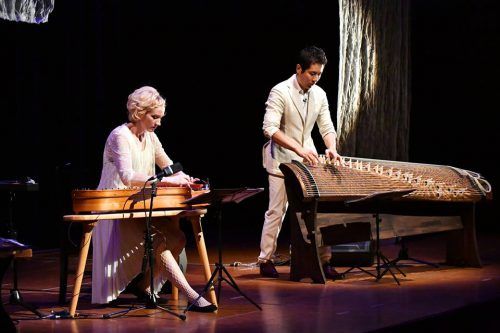CONCERT: EVA-TOMOYA 10TH ANNIVERSARY CONCERT IN SAPPORO


Ying-Shien Chen (MA) is a Taiwanese doctoral student of musicology at the University of Helsinki.
On the evening of the first snowfall in Hokkaido, the Finnish-Japanese duo EVA-TOMOYA held their 10th anniversary concert at the small concert hall in Watanabe Junichi Museum of Literature. The duo consists of the Finnish kantele (Eva Alkula) and the Japanese koto (Tomoya Nakai). Alkula and Nakai have toured several cities in both Finland and Japan since September, and Sapporo is their last stop. The audience of the concert were music lovers and local kantele enthusiasts, including even some fans from Tokyo.
The concert consisted of three parts, including story-telling from a Japanese picture book, a kantele solo, and kantele and koto duo. The first part, Japatora – abbreviated from terms “Japan” and “tradition” – is a new artistic form of Japanese tradition which combines three essential elements: pictured story, story-telling, and music. Three works of art introduced in this concert were made by a Hokkaidoan artist, Keizaburo Tejima. In the opening of the concert, the koto player Nakai and the story-teller chanted in a traditional way that made the atmosphere lively. The story-teller wore a kimono with Finnish national fabric brand Marimekko on the waist sash while the other side was Japanese famous textile, therefore representing the transnational collaboration of the two musicians.
The first picture story Shimafukurō no mizuumi (Owl Lake) depicted an owl family in Hokkaido. In this program, the story flowed with the two players illuminating the ambience with music. In the course of plot, the kantele and the koto mimicked different voices of male and female owls, which made the picture story audible in a surprising way. What impressed me most was depiction of scenery: Nakai used series of rapid notes to illustrate the movement of an owl with its wing spreading in the midair, flying above on the lake and catching fish. The images and the music corresponded to each other quite nicely.
After three picture stories followed a kantele solo of Sibelius’s piece, originally written for the piano. The work demonstrated the classical kantele style with the structure A-B-A: the tempo of A part is adagio while B is allegro or even faster. A was three-beat part with rubato playing, when entering the B part there were successive fast notes which require great skill. Eva played very carefully. This piece brings about the nature of kantele music from Finland, the quiet and unique sound was elegantly presented.
The last piece Youkihi – named after one of four well-known beauties in Chinese history – was a piece composed by Alkula and Nakai. The work demonstrates various expressions on kantele and koto in terms of melody and rhythm, and is also full of Japanese music vocabulary. Although in some parts I thought that the koto overshadowed sound of the cantele, in the end Alkula used chopstick and koto string on kantele strings, which created the tension towards koto and also surprised the listeners. The two cultural objects were well-placed in the piece especially in the stage performance they produced a great effect.
From Helsinki to Tokyo and finally to Sapporo, I followed three of the 10th anniversary concerts. The programs in the three were not exactly the same. I think that the collaboration of two plucked string instruments from the West and the East interestingly embodies the cross-cultural communication in the course of music performance. The two musicians not only create great music but also demonstrate their curiosity to explore the possibilities of two old instruments. In my opinion, this duo has penetrated the layer of sound and brought another cultural meaning towards listeners.
**
Cover photograph: Eva Alkula and Tomoya Nakai performing.
